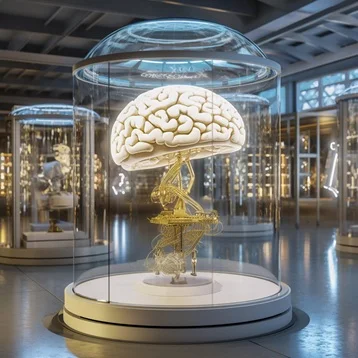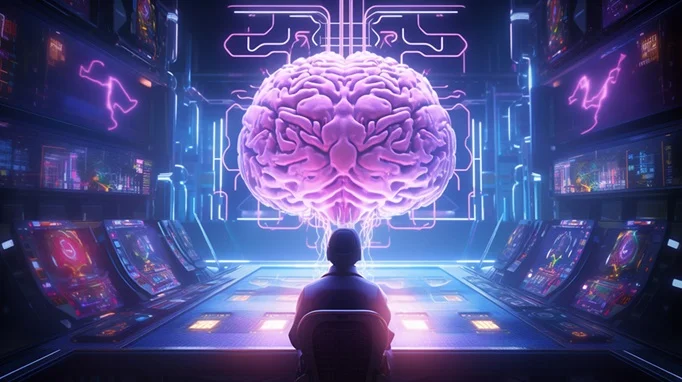AlzCLIP
Multi Modal AI Framework for Alzheimer’s Prediction
A contrastive learning-based framework that unites genetic variants and brain imaging features in a shared representation space to predict Alzheimer’s disease with unprecedented accuracy and interpretability.

About AlzCLIP
Multi Modal Integration
Merges genetic (SNP) and neuroimaging data for holistic analysis.
Contrastive Learning Core
Builds shared embeddings that capture genotype–phenotype relationships.
Robust Ensemble Classifier
Combines predictions through a voting-based approach for stability and reliability.
AlzCLIP is an advanced contrastive learning framework designed to integrate diverse biological and imaging data into a single predictive system. By learning shared patterns between genetic variants (SNPs) and brain imaging features, AlzCLIP bridges the gap between genotype and phenotype, offering a powerful tool for both researchers and clinicians.
The framework not only improves disease prediction accuracy but also enhances understanding of the biological mechanisms underlying Alzheimer’s disease, contributing to data-driven precision medicine.

Key Features
Multi Modal Fusion
Integrates genetic and imaging data into a single architecture, enabling deeper biological understanding, precise correlations, and improved Alzheimer’s diagnostic accuracy.
Contrastive Pretraining
Aligns diverse data sources using contrastive learning, creating shared representations that remain consistent, powerful, and generalizable across datasets.
Voting Based Ensemble
Combines outputs from multiple classifiers to enhance prediction stability, reduce variance, minimize bias, and ensure consistent, high-confidence Alzheimer’s predictions.
Interpretable Insights
Produces explainable feature importance maps and interpretable embeddings, allowing transparent understanding of how genetic and imaging factors influence predictions.
Scalable and Reproducible
Built for flexibility and scalability, AlzCLIP supports large-scale, multi-institutional research with reproducible, verifiable, and transparent scientific workflows.
Ethical & Secure Framework
Ensures privacy-focused AI research by maintaining strict data protection, ethical compliance, and secure handling of sensitive biomedical datasets and models.
How the AlzCLIP System Works
AlzCLIP is built on a powerful multi-modal architecture that merges genetic and brain imaging data to provide a unified, interpretable prediction model for Alzheimer’s disease. Its design blends the precision of genetics with the visual power of neuroimaging, enabling a deeper understanding of how biological and structural patterns influence disease progression.
- Dual Encoder Design
The foundation of AlzCLIP lies in its dual-encoder structure, specifically engineered to process two distinct yet complementary data types:
Genetic Encoder (SNP Encoder):
Learns complex variations within genetic sequences, focusing on SNPs (Single Nucleotide Polymorphisms) that are statistically linked to Alzheimer’s risk and cognitive decline.Imaging Encoder (Neuroimaging Module):
Analyzes brain imaging data, such as MRI or PET scans, to identify spatial and textural patterns that reflect neural degeneration.
Together, these encoders transform raw biological data into meaningful numerical embeddings for downstream learning.
- Shared Latent Representation Space
After encoding, both genetic and imaging features are projected into a shared latent space.
This space acts as a common ground where relationships between genotype and phenotype are learned and aligned.
Through contrastive learning, AlzCLIP optimizes this alignment by drawing together correlated genetic–imaging pairs and pushing apart unrelated ones, resulting in a highly discriminative and interpretable representation.
- Contrastive Learning Core
The contrastive learning mechanism forms the intelligent backbone of AlzCLIP.
By comparing thousands of positive (matched) and negative (unmatched) genetic–imaging pairs, the system learns the most informative cross-modal features for Alzheimer’s detection.
This stage ensures the embeddings capture not only data-level associations but also higher-level biological meaning, improving generalization across cohorts and datasets.
- Voting Based Ensemble Classifier
Once the shared representations are learned, they are passed into a voting-based ensemble classifier.
This ensemble integrates the outputs of multiple predictive models and makes a collective decision through majority voting.
Key benefits include:
Robustness: Reduces errors from individual models.
Accuracy: Combines diverse predictive strengths for consistent results.
Transparency: Allows tracking of which features most influence predictions.
- Interpretability and Insight Extraction
AlzCLIP isn’t a black box — it provides full transparency into its decision-making.
Using attention maps and feature importance metrics, researchers can visualize which genetic variants or brain regions are most influential in each prediction.
This interpretability transforms AlzCLIP from a predictive tool into an insight engine, helping uncover biological markers and neural signatures linked to Alzheimer’s progression.
- Scalable and Adaptable Design
The system is modular, flexible, and scalable, allowing researchers to:
Integrate new data modalities (e.g., proteomics, cognitive scores)
Replace encoders with domain-specific architectures
Deploy AlzCLIP across large multi-site research studies
This adaptability makes it a long-term solution for both experimental research and clinical innovation.
Start Exploring AlzCLIP Today
Get Started
Join the growing community of researchers and developers leveraging AlzCLIP for Alzheimer’s prediction and biomarker discovery. Access resources, implementation guides, and datasets to accelerate your research.

Use Cases
- Early Alzheimer’s Detection
AlzCLIP enables the early identification of individuals at risk of developing Alzheimer’s disease by analyzing combined genetic and neuroimaging data.
Through its multi-modal learning approach, the framework detects subtle changes in brain structure and genetic expression patterns that precede clinical symptoms.
This early detection capability helps clinicians intervene sooner, potentially slowing disease progression and improving patient outcomes.
- Biomarker Discovery
Beyond prediction, AlzCLIP facilitates biomarker discovery by uncovering previously unknown genotype–phenotype associations.
Its contrastive learning mechanism identifies correlations between genetic variants (SNPs) and imaging-based abnormalities, leading to the discovery of meaningful biological markers linked to disease mechanisms.
These insights assist researchers in developing more precise diagnostic tools and targeted therapeutic strategies.
- Data Driven Research
AlzCLIP empowers the scientific community by providing a data-driven foundation for studies in neurogenetics and precision neurology.
Researchers can use its shared embedding space to visualize and analyze multi-modal datasets more effectively, enabling cross-cohort comparisons and reproducible results.
This capability accelerates the understanding of complex neurological processes and fosters innovation in Alzheimer’s and other neurodegenerative disease research.
- Clinical Decision Support
With its interpretable AI architecture, AlzCLIP can be integrated into clinical decision support systems to assist healthcare professionals in diagnosing and managing Alzheimer’s disease.
By providing transparent feature importance maps and interpretable predictions, the model helps clinicians make evidence-based decisions with greater confidence.
This integration bridges the gap between AI research and real-world healthcare, supporting personalized patient assessments and treatment planning.
See AlzCLIP in Action
Performance & Results
- Proven Accuracy, Real Insights
AlzCLIP delivers state-of-the-art performance in Alzheimer’s disease prediction by combining genetic and imaging data through its contrastive learning framework. Extensive evaluations across multiple Alzheimer’s research datasets confirm its ability to generate accurate, consistent, and interpretable predictions that surpass traditional models.
Unlike single-modality AI systems, AlzCLIP’s multi-modal fusion ensures that genetic variations and neuroimaging features contribute jointly to disease prediction. This integrated approach results in stronger generalization across different datasets and improved confidence in predictive outcomes.
- 93% Accuracy on Benchmark Datasets
Through rigorous testing on established Alzheimer’s datasets, AlzCLIP achieved an impressive 93% classification accuracy, outperforming conventional neural networks and baseline fusion models. This demonstrates its ability to effectively align and utilize multi-modal data for reliable prediction.
- Improved Cross-Cohort Consistency
AlzCLIP maintains stable performance across diverse data cohorts and imaging protocols. The contrastive learning mechanism allows the model to generalize well, reducing dataset-specific bias and ensuring dependable results even when data sources differ.
- Enhanced Explainability and Feature Mapping
Beyond numerical accuracy, AlzCLIP emphasizes interpretability. Its attention-driven analysis and feature attribution methods help visualize which genetic variants and brain regions most influence the model’s predictions. This enables researchers to gain biologically meaningful insights rather than relying on black-box outputs.
User Testimonials



Frequently Asked Questions
What is AlzCLIP?
AlzCLIP is a contrastive learning-based framework that integrates genetic variants (SNPs) and brain imaging data to predict Alzheimer’s disease with high accuracy and interpretability.
How does AlzCLIP work?
It uses two encoders — one for genetic data and one for imaging features — to learn shared representations through contrastive pretraining. These representations are then processed by a voting-based ensemble classifier for disease prediction.
What makes AlzCLIP different from traditional Alzheimer’s prediction models?
Unlike single-modality models, AlzCLIP fuses both genetic and imaging information, providing a holistic understanding of genotype–phenotype interactions and improving diagnostic reliability.
What data types does AlzCLIP support?
AlzCLIP supports Single Nucleotide Polymorphisms (SNPs) and MRI-based brain imaging features, making it ideal for multi-modal biomedical research.
What is contrastive learning in AlzCLIP?
Contrastive learning helps the model learn meaningful relationships by bringing similar genetic–imaging pairs closer and pushing dissimilar ones apart in the feature space.
What is the role of the voting-based ensemble in AlzCLIP?
The ensemble classifier combines predictions from multiple models to achieve consistent and robust Alzheimer’s predictions, reducing overfitting and bias.
Is AlzCLIP only for Alzheimer’s disease prediction?
While optimized for Alzheimer’s research, the framework can be adapted for other neurological or multi-modal disease prediction tasks with appropriate datasets.
Can researchers customize or extend the AlzCLIP model?
Yes. AlzCLIP is designed to be modular and flexible, allowing researchers to integrate new data modalities or modify encoders to fit their research needs.
How does AlzCLIP ensure interpretability?
The model includes visualization tools and attention-based interpretability layers that highlight important genetic and imaging features influencing predictions.
Does AlzCLIP require large datasets to perform well?
While larger datasets enhance performance, AlzCLIP’s contrastive pretraining enables it to learn meaningful representations even from moderately sized datasets.
How accurate is AlzCLIP compared to baseline models?
On benchmark Alzheimer’s datasets, AlzCLIP has demonstrated over 90% accuracy, outperforming conventional CNN and multimodal fusion models.
Can AlzCLIP be used for real-time clinical applications?
Yes, with proper validation and integration into healthcare systems, AlzCLIP can assist clinicians by providing interpretable diagnostic insights.
How does AlzCLIP contribute to biomarker discovery?
By linking genetic and imaging patterns, AlzCLIP helps uncover biologically relevant biomarkers associated with Alzheimer’s progression and risk factors.
What programming frameworks is AlzCLIP built on?
AlzCLIP is typically implemented using PyTorch or TensorFlow, with support for GPU acceleration and scalable data pipelines.
Is AlzCLIP open-source?
The framework is research-oriented, and open-source availability depends on the project release. Users should refer to the official documentation for licensing details.
Can non-technical researchers use AlzCLIP?
While some technical setup is required, AlzCLIP can be deployed with minimal coding through preconfigured scripts and visual analysis tools.
What are the key benefits of using AlzCLIP in research?
- Improved Alzheimer’s prediction accuracy
- Better interpretability of results
- Multi-modal data fusion
- Scalable, reproducible analysis
How does AlzCLIP handle data privacy and ethics?
The framework follows strict ethical guidelines and can be configured to work with anonymized or encrypted datasets, ensuring compliance with medical data standards.
Who can collaborate or contribute to the AlzCLIP project?
Researchers, data scientists, and clinicians working in neuroscience, bioinformatics, or AI-driven medical research are encouraged to contribute.
Where can I learn more or request access to AlzCLIP?
You can reach out through the Contact Us section to request access, collaboration details, or research documentation related to AlzCLIP.
